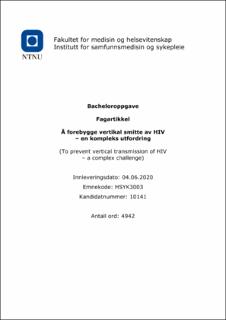| dc.contributor.advisor | Hadders, Hans | |
| dc.contributor.author | Nyerrød, Karen Marie Østeng | |
| dc.date.accessioned | 2020-07-19T16:00:39Z | |
| dc.date.available | 2020-07-19T16:00:39Z | |
| dc.date.issued | 2020 | |
| dc.identifier.uri | https://hdl.handle.net/11250/2669601 | |
| dc.description.abstract | Introduksjon: Forente nasjoner (FN) har som ett av sine bærekraftsmål å forebygge nye tilfeller av HIV. Smitte fra mor til barn, vertikal smitte, er et av områdene som har fått særlig fokus. Gjennom organiserte programmer og tiltak har sykepleiere en viktig oppgave: Å følge opp tiltak der risikoen for smitte er størst – gjennom svangerskap, fødsel og amming. Hensikten med denne studien er å undersøke hvordan sykepleiere på sykehus i Namibia bidrar til å forebygge vertikal smitte av HIV.
Metode: Kvalitativ metode er brukt i denne studien. Ett pilotintervju og tre semistrukturerte intervjuer ble gjennomført ved fire ulike avdelinger på to offentlige sykehus i Namibia. Egne ustrukterte og strukturerte observasjoner er inkludert. Dataene blir sett på i sammenheng med relevant forskning og teori. Analysen ble gjort etter inspirasjon av Dallands prinsipper for analyse.
Resultater: Alle sykepleierne i studien utrykte at det var viktig å sette inn tiltak der risikoen for smitte er størst. HIV-testing var essensielt for å starte behandling. Veiledning og informasjon gjennom undervisning til mødrene ble gitt både i grupper og individuelt. Målet var at mødrene skulle forstå det som ble sagt, for å kunne ta informerte valg rundt egen helse. Medisiner ble sett på som det viktigste enkelttiltaket, mens etterfølgelse av behandling var nødvendig ved eksklusiv amming. Sosiale og økonomiske forhold har en avgjørende rolle i alle punktene.
Konklusjon: Namibia har et velfungerende system for forebygging av vertikal smitte på både nasjonalt og individuelt nivå. Sykepleierne i min studie viste kunnskap rundt forebygging av HIV. Det viser seg imidlertid at sykepleierne står ovenfor utfordringer knyttet til liten tid og høy arbeidsmengde. Sosiale og økonomiske forhold påvirker deres arbeid med pasientene. Ved å gi mer tid og anerkjennelse av sykepleiernes arbeid kan man anta at det vil bidra til å stanse epidemien av AIDS innen 2030. | |
| dc.description.abstract | Introduction: The United Nation (UN), have in their sustainable development goals included the prevention of new HIV-cases. Transmission from mother to child, vertical transmission, is particularly emphasized. Through organized programs and measures, nurses have an important task: To follow up measures where the risk of infection is greatest - through pregnancy, childbirth and breastfeeding. The purpose of this study was to investigate how nurses at the hospitals in Namibia contribute to preventing vertical transmission of HIV.
Method: A qualitative method is used in this study. One pilot interview and three semi-structured interviews were conducted at four different departments of two public hospitals in Namibia. Own structured- and unstructured observations are included. The data is viewed in the context of relevant research and theory. The analysis was carried out according to Dalland's principles for analysis.
Results: All the nurses in the study thought it was important to put measures in place where the risk of infection is greatest. HIV-testing was essential to start treatment. Counseling and information through education was given in both groups and individually, to make sure that the mothers understood the information and could make informed choices. Medications were put in as the most important measure, while follow-up treatment was necessary through the breastfeeding period. Social and economic conditions play a crucial role in all these factors.
Conclusion: Namibia has an effective system for the prevention of vertical transmission at both national and individual levels. The nurses in my study had good knowledge about prevention of HIV. However, it seems that nurses are facing challenges due to a shortage of time and high workloads. Social and economic conditions affect their work with the patient. By giving more time and recognition of the nurses' work, one can assume it will help stop the epidemic of AIDS by 2030. | |
| dc.publisher | NTNU | |
| dc.title | Å forebygge vertikal smitte av HIV - en kompleks utfordring | |
| dc.type | Bachelor thesis | |
